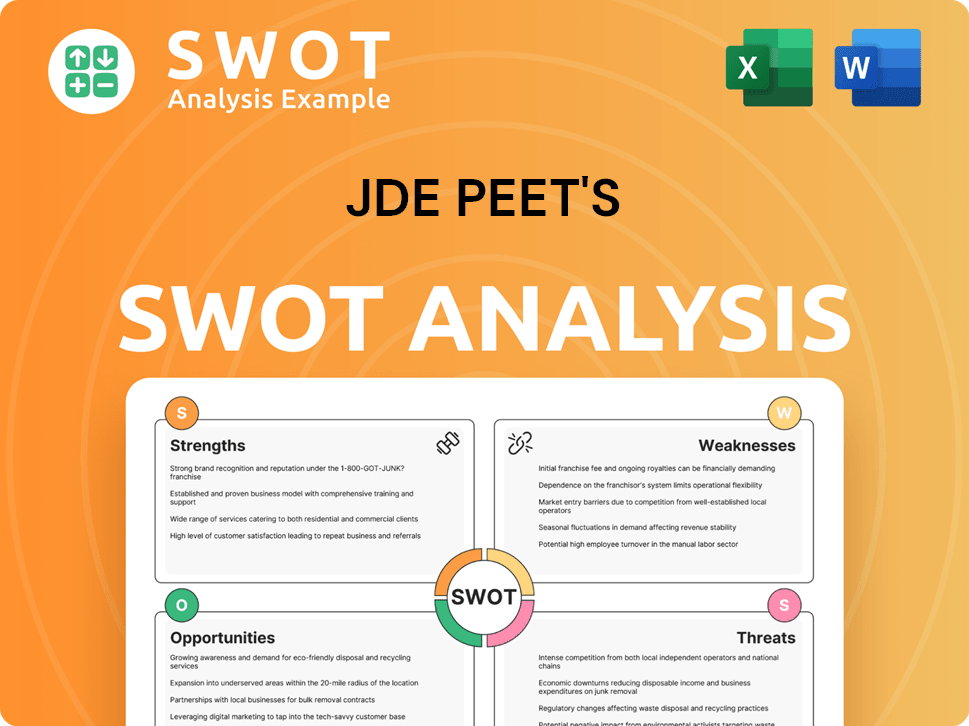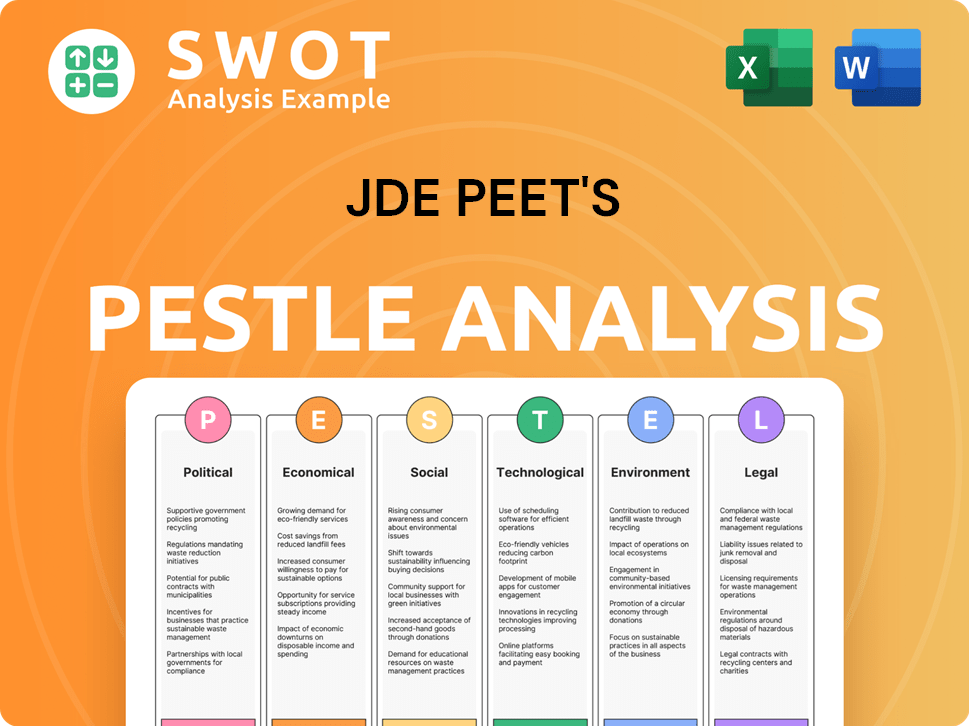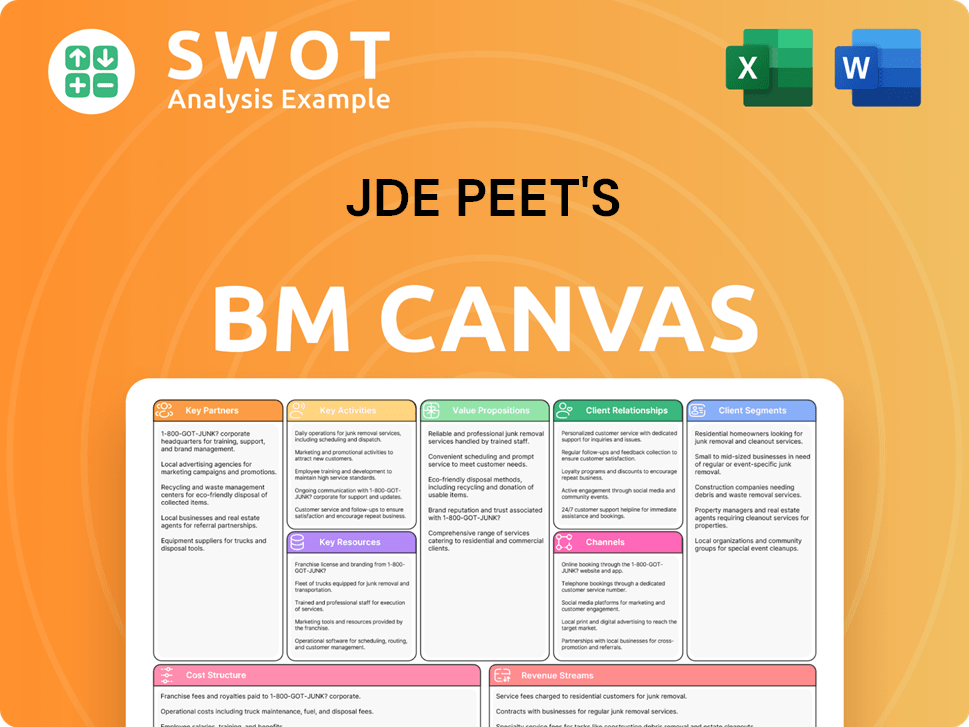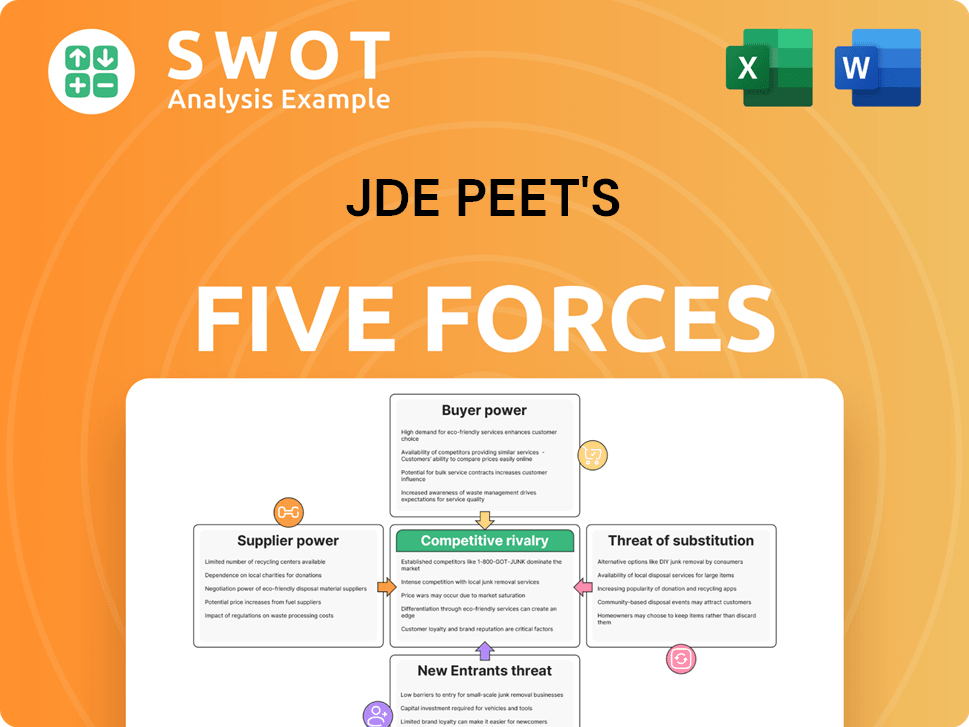JDE Peet's Bundle
How Did a Dutch Grocery Store Become a Global Coffee Giant?
JDE Peet's, a name synonymous with coffee and tea worldwide, boasts a rich JDE Peet's SWOT Analysis that spans centuries. From its 18th-century Dutch origins to its current status, the company's evolution is a compelling story of adaptation and strategic foresight. Discover how a small grocery business transformed into the world's largest pure-play coffee and tea company.

This journey, marked by key acquisitions and expansions, reveals the JDE Peet's history and its resilience in a competitive market. Understanding the Peet's Coffee history and the JDE Peet's company origin provides invaluable insights into its enduring success. Explore the pivotal moments that shaped this global beverage leader and its enduring impact on the coffee industry.
What is the JDE Peet's Founding Story?
The JDE Peet's history is a story of entrepreneurial beginnings and strategic expansions. It began in 1753 with a small grocery store in the Netherlands, evolving into a global coffee and tea powerhouse. This journey showcases the company's adaptability and growth over centuries.
The roots of JDE Peet's trace back to the establishment of 'De Witte Os' (The White Ox) in Joure, Friesland. This early venture focused on providing quality groceries, including coffee, tea, and tobacco. This initial focus on everyday provisions laid the groundwork for a business built on consistent product delivery.
The company's origin is deeply intertwined with the Douwes family, starting with Egbert Douwes and his wife Akke Thysses. Their vision of offering quality goods to the local community set the stage for what would become a significant player in the global coffee market. The evolution from a local store to a global enterprise is a testament to the enduring appeal of coffee and tea.
The JDE Peet's company story begins in 1753 with a general grocery store in the Netherlands. This store, 'De Witte Os,' focused on selling groceries, including coffee, tea, and tobacco, marking the initial step in the long history of the company.
- Egbert Douwes and Akke Thysses founded 'De Witte Os' in Joure, Friesland, in 1753.
- The business initially focused on processing and selling groceries, with coffee, tea, and tobacco as key products.
- Douwe Egberts, the son, took over in 1780 and expanded the business beyond Joure.
- The company's early success was due to its ability to adapt to changing consumer tastes and expand its reach.
JDE Peet's SWOT Analysis
- Complete SWOT Breakdown
- Fully Customizable
- Editable in Excel & Word
- Professional Formatting
- Investor-Ready Format

What Drove the Early Growth of JDE Peet's?
The early growth and expansion of JDE Peet's, formerly known as Douwe Egberts, began in the Netherlands, establishing itself as a prominent regional player. This initial phase involved product diversification and team expansion to meet growing demand. The company's early success was built on reliable products and increased market penetration within Dutch cities and towns. This period set the stage for significant advancements in the coffee company history.
A pivotal shift occurred in the early 20th century with the move to industrial-scale production. This involved building larger facilities to meet increasing national demand. This strategic change allowed for wider distribution and greater market reach. This expansion was crucial for the continued growth of the Dutch coffee company.
The mid-20th century marked the beginning of JDE Peet's international expansion, starting with neighboring European countries. The acquisition history of other regional coffee and tea brands further strengthened its market position. Leadership transitions, with professional management taking over, brought new strategic perspectives.
The 2015 merger of D.E Master Blenders 1753 and the coffee business of Mondelēz International was a significant milestone in JDE Peet's history, accelerating global expansion. The acquisition of Peet's Coffee in 2019 further solidified its position, leading to the rebranding as JDE Peet's. The company's IPO in 2020 raised approximately €2.25 billion, demonstrating strong market reception. For more insights, check out the Marketing Strategy of JDE Peet's.
JDE Peet's continues to expand its presence in emerging markets and enhance its e-commerce capabilities. The company's ability to adapt to evolving consumer purchasing habits is crucial for future growth. As of early 2024, JDE Peet's has a strong global presence and continues to explore new opportunities within the coffee market.
JDE Peet's PESTLE Analysis
- Covers All 6 PESTLE Categories
- No Research Needed – Save Hours of Work
- Built by Experts, Trusted by Consultants
- Instant Download, Ready to Use
- 100% Editable, Fully Customizable

What are the key Milestones in JDE Peet's history?
The JDE Peet's history, and its predecessors, is marked by significant milestones, from its early days to its current global presence. This Dutch coffee company has grown through strategic acquisitions and innovative product launches, establishing itself as a major player in the coffee and tea industry. The JDE Peet's company has a rich past, with key moments shaping its trajectory.
| Year | Milestone |
|---|---|
| 1753 | The origins of the company can be traced back to the founding of a grocery store in Joure, Netherlands, marking the beginning of its long history. |
| 1966 | Alfred Peet opens his first coffee store in Berkeley, California, which would later become a cornerstone of the specialty coffee movement. |
| 2012 | Douwe Egberts and Mondelez International's coffee business merge to form a new company, creating a global coffee and tea powerhouse. |
| 2014 | The new company is renamed Jacobs Douwe Egberts (JDE), signaling a new era of growth and expansion. |
| 2019 | JDE merges with Peet's Coffee to form JDE Peet's, solidifying its position in the premium coffee market. |
| 2020 | JDE Peet's lists on Euronext Amsterdam, marking a significant moment in its financial history. |
Throughout its history, JDE Peet's has been at the forefront of innovation in the coffee and tea industry. The company has consistently introduced new products and formats to meet evolving consumer preferences. For a deeper understanding of JDE Peet's's strategic approach, consider exploring the Target Market of JDE Peet's.
Early adoption of advanced roasting and packaging techniques ensured consistent quality and extended shelf life for coffee and tea products. This was crucial for maintaining product freshness and flavor.
The company introduced numerous iconic coffee and tea brands, many of which have become household names globally. These brands have helped to establish a strong market presence.
The introduction of convenient coffee formats, such as Senseo coffee pods in partnership with Philips, revolutionized in-home coffee consumption. This innovation catered to the growing demand for convenience.
Investing in responsible sourcing initiatives and certifications, such as Rainforest Alliance, to meet the increasing demand for sustainable and ethically sourced products. This reflects a commitment to environmental and social responsibility.
Continuous development of new coffee and tea products, including variations in flavors, blends, and brewing methods, to cater to diverse consumer tastes. This keeps the company competitive.
Embracing digital technologies to enhance customer engagement, improve supply chain efficiency, and optimize marketing strategies. This includes e-commerce platforms and data analytics.
The JDE Peet's company has faced various challenges, including market downturns and intense competition. Navigating the shift in consumer preferences and maintaining a diversified brand portfolio have also been crucial.
Economic recessions have impacted consumer spending on discretionary items like premium coffee, affecting sales and revenue. The company must adapt to changing economic conditions.
Intense competition from both established global players and agile local brands has necessitated continuous innovation and strategic marketing. The market is highly competitive.
Product failures or underperforming brands have required strategic divestitures or rebranding efforts, impacting financial performance. The company must manage its brand portfolio effectively.
Navigating the shift from traditional in-home coffee preparation to single-serve systems and out-of-home consumption required significant investment and adaptation. This includes understanding consumer behavior.
Global events and other factors have caused supply chain disruptions, impacting the availability of raw materials and finished products. This requires robust supply chain management.
Economic and political instability in key markets can affect consumer spending and operational costs. The company must be prepared for global economic uncertainties.
JDE Peet's Business Model Canvas
- Complete 9-Block Business Model Canvas
- Effortlessly Communicate Your Business Strategy
- Investor-Ready BMC Format
- 100% Editable and Customizable
- Clear and Structured Layout

What is the Timeline of Key Events for JDE Peet's?
The JDE Peet's history is a journey from a small grocery store to a global coffee and tea giant. The Dutch coffee company has a rich past, marked by strategic acquisitions and expansions. The Peet's Coffee history is also a significant part of the overall story. The company's evolution reflects its adaptability and commitment to the evolving tastes of consumers worldwide. This coffee company history showcases the company's growth over centuries.
| Year | Key Event |
|---|---|
| 1753 | Egbert Douwes establishes a grocery store in Joure, Netherlands, laying the foundation for Douwe Egberts. |
| 1780 | Douwe Egberts, son of the founder, takes over the business and expands its reach. |
| Early 1900s | Douwe Egberts expands into industrial-scale production and national distribution in the Netherlands. |
| Mid-20th Century | Douwe Egberts begins international expansion into European markets. |
| 2001 | Launch of Senseo coffee pods in partnership with Philips, revolutionizing home coffee brewing. |
| 2012 | Sara Lee spins off its international coffee and tea business to form D.E Master Blenders 1753. |
| 2015 | D.E Master Blenders 1753 merges with the coffee business of Mondelēz International to create Jacobs Douwe Egberts (JDE). |
| 2019 | JDE acquires Peet's Coffee, leading to the formation of JDE Peet's. |
| 2020 | JDE Peet's successfully completes its Initial Public Offering (IPO) on Euronext Amsterdam, raising approximately €2.25 billion. |
| 2024 | JDE Peet's reports a net sales increase of 2.1% organically in Q1 2024, driven by positive volume/mix development and pricing. |
JDE Peet's is focused on expanding into emerging markets, particularly in Asia and Latin America. These regions present significant growth opportunities due to rising coffee consumption. This strategic move is part of the company's broader plan to increase its global footprint and market share. The company aims to capitalize on the growing demand for coffee and tea in these dynamic markets.
Innovation is a core pillar for JDE Peet's, with plans for new product developments in sustainable coffee and tea. The company is also investing in convenient at-home and out-of-home solutions. JDE Peet's is committed to its sustainability agenda, targeting 100% responsibly sourced coffee and tea by 2025. This commitment reflects the company's dedication to environmental and social responsibility.
JDE Peet's expects its adjusted EBIT to grow organically by mid-single-digit in 2024, demonstrating confidence in its strategic direction. Analyst predictions suggest continued resilience in the coffee market. This positive outlook is supported by the company's strong brand portfolio and global reach. The company's financial performance in 2024 is expected to reflect its strategic initiatives.
JDE Peet's is well-positioned to capitalize on market trends due to its strong brand portfolio and global reach. The company's future direction remains rooted in its founding vision of providing quality coffee and tea. This vision is adapted for a globalized and sustainability-conscious world. The company's ability to adapt and innovate will be key to its continued success.
JDE Peet's Porter's Five Forces Analysis
- Covers All 5 Competitive Forces in Detail
- Structured for Consultants, Students, and Founders
- 100% Editable in Microsoft Word & Excel
- Instant Digital Download – Use Immediately
- Compatible with Mac & PC – Fully Unlocked

Related Blogs
- What is Competitive Landscape of JDE Peet's Company?
- What is Growth Strategy and Future Prospects of JDE Peet's Company?
- How Does JDE Peet's Company Work?
- What is Sales and Marketing Strategy of JDE Peet's Company?
- What is Brief History of JDE Peet's Company?
- Who Owns JDE Peet's Company?
- What is Customer Demographics and Target Market of JDE Peet's Company?
Disclaimer
All information, articles, and product details provided on this website are for general informational and educational purposes only. We do not claim any ownership over, nor do we intend to infringe upon, any trademarks, copyrights, logos, brand names, or other intellectual property mentioned or depicted on this site. Such intellectual property remains the property of its respective owners, and any references here are made solely for identification or informational purposes, without implying any affiliation, endorsement, or partnership.
We make no representations or warranties, express or implied, regarding the accuracy, completeness, or suitability of any content or products presented. Nothing on this website should be construed as legal, tax, investment, financial, medical, or other professional advice. In addition, no part of this site—including articles or product references—constitutes a solicitation, recommendation, endorsement, advertisement, or offer to buy or sell any securities, franchises, or other financial instruments, particularly in jurisdictions where such activity would be unlawful.
All content is of a general nature and may not address the specific circumstances of any individual or entity. It is not a substitute for professional advice or services. Any actions you take based on the information provided here are strictly at your own risk. You accept full responsibility for any decisions or outcomes arising from your use of this website and agree to release us from any liability in connection with your use of, or reliance upon, the content or products found herein.